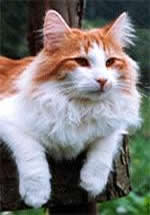FIFé Standard
Norwegian Forest Cats (NFO)
General |
Size |
Large |
|---|---|---|
Head |
Shape |
Triangular, where all sides are equally long. |
Chin |
Firm. |
|
Ears |
Shape |
Large, with good width at the base. |
Placement |
High and open, so that the outer lines of the ears follow the line of the head down to the chin. |
|
Eyes |
Shape |
Large and oval, well opened, set slightly oblique. |
Expression |
Alert expression. |
|
Color |
All colours permitted, regardless of coat colour. |
|
Body |
Structure |
Long, strongly built; solid bone structure. |
Legs |
Structure |
Strong, high on legs; hind legs higher than the front legs. |
Paws |
Large, round, in proportion to the legs. |
|
Tail |
Structure |
Long and bushy. |
Coat |
Structure |
Semi-long. |
Color |
All colours are permitted, including all colours with white; except pointed patterns and chocolate, lilac, cinnamon and fawn. Any amount of white is allowed, i.e. a white blaze, white locket, white chest, white on the belly, white on the paws, etc. |
|
Remarks |
General |
Very slow maturing of this breed should be taken into account. |
Head |
Mature males may have broader heads than females. |
|
Coat |
Coat is evaluated only on texture and quality. |
Commentaries of the Standard
 From my point of view the Norwegian Forest Cat must be harmonious on the whole and the chest cavity must be wide and great. It is important not to lose the height of the later legs and the distance between the chest and the ground. We must not forget that they must be protected of the snow.
From my point of view the Norwegian Forest Cat must be harmonious on the whole and the chest cavity must be wide and great. It is important not to lose the height of the later legs and the distance between the chest and the ground. We must not forget that they must be protected of the snow.
I dont want to have an argument regarding the size and weight. It's not the ideat to create heavier or lighter, bigger or smaller cats though it's clear that small or weak ones must be rejected to raise; as selectors we know when a cat is quite balanced in its totality and which must be its exact weight (which varies according to line and unit).The experience showed me that the litters that better are developed usually are those born in spring as it is his natural time of young.
The head. I must insist on the importance of a straight profile that gives you an impression of smart and serious listening of what you're saying. The standard adds a phrase that maybe confusing if the person was not an expert in watching Norwegian: "form of equilateral triangle", to add next "long", and that's the image of the head as a whole, in which the situation of the ears or the importance of the chin would enlarge the aesthetic, also depending on the birth of the nose.
There are cats that have the birth of the nose higher than others and the forehead slightly convex; it's usually defined as "sheep head"; nevertheless it is essential to keep the characteristics of an equilateral triangle, typical of this race and dont forget that it must accompanied of a strong chin, and watch that triangle from the base of the ears towards the chin. Thus we will learn how to see the whole head considering and respecting the standard of the race.
We always hear about the old or new type, does have no sense: for me there are neither old nor new types, but well or bad typed cats, the photos of their forebears will show it; anyway each one must know the ideal of Norwegian to reach; there are different tastes, but only the constancy and a strong selection will approach to the perfect Norwegian, the one with whom all we dream of, always according with our way to of seeing the aesthetic of the cat.
The ears, must be wide in the base enabling him to listen what the nature whispers to him for surviving. They must be protges by finished tufos and in plumetis that helps to camouflage and mimicry in their natural surroundings. Unfortunately it is not easy to find exemplary with great plumetis and in Norway they are very worried about his issue.
The eyes, of the Norwegian, further than big, slightly oval and oblique they have an alert glance, always ready to hunt and to defend their puppies, but also sweet. They do not have to be deep like sunk in the face. The glance of a Norwegian is frank.
The hair is something special and specific of this race, that natural shelter is its defense against the climate; it must be longer in the collar, trousers and tail; all this will protect them from the cold. When they are curled up to sleep all the cat will be covered and protected. Coming older they develop a hair that start exactly behind the front legs, giving them a gorgeous appearance, the quantity and quality of the hair on Norwegians is another data to consider, the subhair must be stiff, and the outer, long and impermeable, because it is the mantle and its distribution on the body that define the final look of a Norwegian. The care of the hair is easy: a regular hairdo is enough to maintain its layer flaming.
In summer it will be put in short sleeve; with the arrival of the autumn it will release a rutilante fur coat made by himself.
The colors, of the layer are all those that can be found of spontaneously in the nature, although there is a classic frequent scheme: the black tabby with white. The distribution of the white on the body will be defined by poligenes that normally they are inherited from the forebears. All we are accustomed to see the typical scheme of white on the face in form of an inverted V accompanied by a white necklace and mittens in the legs; lately it is being seen in very famous cats and of very prestigious lines that the quantity of white has increased and inverted V arrives higher, but the Forests are not selected by neither the color nor the distribution of the white on the body, it's very personal to feel more atracted by one or other issue.
With the appearance in Sweden of the chocolate and lilac lines the controversy is served, because these colors are not admitted because they do not exist in a natural way and only future crossings of these lines will let us tracking back to know how this evolution has been possible without intervention of the man. At the moment they are neither recognized nor official demands of recognition of these colors have been setted.
The tail must be long in proportion to the size of the body, but for sure very leafy and luxuriant in order that when taking shelter on itself it covers him together with thick necklace and the long trousers covers completely giving him a full warm sensation.
The Standard of the Norwegian Forest Cat has under gone a slight change in may 1993. At the beginning there were only four colour distinctions made at the time of competition and therefore a red tabby mackerel cat competed with a black tabby mackerel, so it was almost impossible to get a CAC considering the hughe amount of Norwegian Forest Cats that attended every show. This happened before the categories where opened and today from the former four we have now nive which I explain next.
- Group 1: Black and Blue
- Group 2: The same with white
- Group 3: Black, Blue and Aguti.
- Group 4: The same with white
- Group 5: Red, Cream, Tortishell, Aguti and Non Aguti.
- Group 6: The same with white
- Group 7: Black, Blue, Red, Cream, Tortishell, Silver and Smoke.
- Group 8: The same with white
- Group 9: White
Comments:
Carmen Hierro & Maribel Lerones
